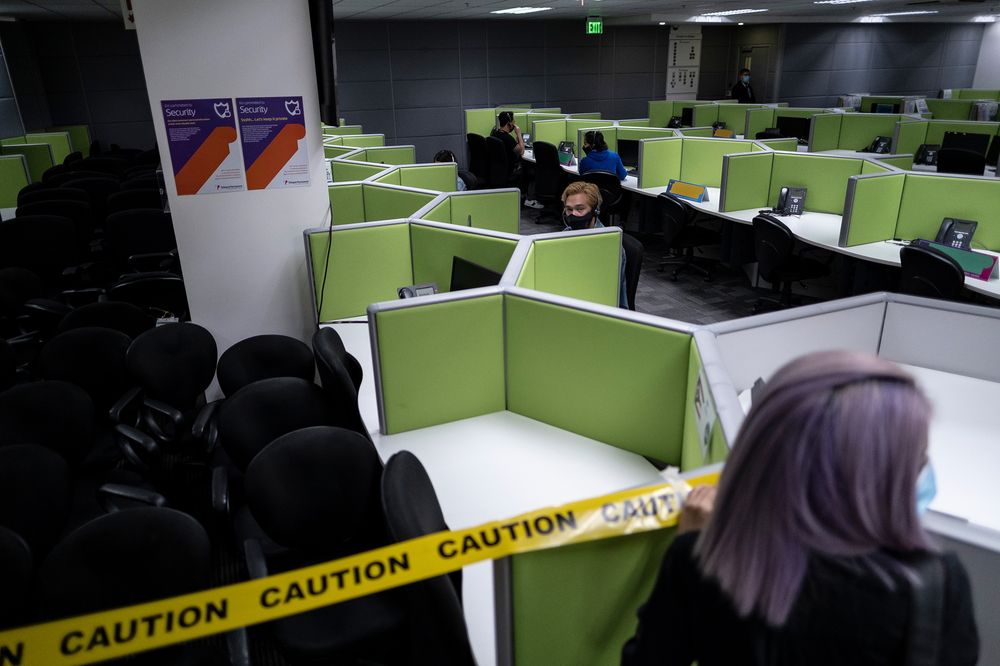Concern about data security, power outages, and poor internet service fuels a return to offices.
For Americans with questions about their bank accounts, mobile phone service, or e-commerce orders, getting answers has long involved talking on the phone with someone in the Philippines, where English-speaking operators handle queries, complaints, and other calls. U.S. companies outsourcing this kind of customer service benefit from lower labor costs while counting on their Philippine operators to keep customers’ confidential information safe within the walls of the call centers.
Now the coronavirus is testing that arrangement. After the Philippine government imposed a strict quarantine in March, call centers had permission to keep skeleton crews at their offices, but they had to send thousands of other employees to work from home. Even as lockdowns end in the island nation, social distancing rules remain in effect. Many staffers won’t be returning to call centers and instead will be answering customer questions from their residence.
That decision has forced Alorica Inc., a major operator of call centers in the country, to work with clients to revise their agreements about what kinds of information workers can handle outside the office. The closely held company based in Irvine, Calif., has about 40,000 employees in the Philippines, half of its total workforce, and must limit occupancy at its 22 sites there to 50% of capacity to reduce the risk of workplaces becoming Covid‑19 hot spots.
Some jobs, therefore, must go off-site, says Bong Borja, Alorica’s president of Asia-Pacific operations. “The ones that are really sensitive, we are trying to keep in the office,” he says. “If there’s no credit card information, credit information, health information—those are ones that can be done at home.”
The call center business is a crucial one for the Philippines, accounting for about 8% of gross domestic product and directly employing 1.3 million people, according to HSBC Holdings economist Noelan Arbis. So the nation is relying on Alorica and other operators to quickly come up with solutions to keep the industry growing.
Reopening the offices safely won’t be easy, says Karen Harris, New York-based managing director of the Macro Trends Group at consulting firm Bain & Co. “These call centers are typically densely occupied, which makes it challenging to protect workers’ health,” she says. Just as the act of singing seems to spread the virus through droplets in the air, Harris says, talking on the phone for hours may be higher-risk. “You can imagine that speaking all day would raise the risk of transmission.”
As many continue to work from home, staffers are having to become more self-reliant when they have questions about their work, says Migz Moreno, who can’t disclose the name of his employer because he isn’t authorized to speak with the media. Without managers around, “if you need any support, it’s not given instantly,” he says. “You have to troubleshoot yourself sometimes.”
Moreno works late at night and is on his own while the rest of the household is asleep. The isolation is a big change from his old way of working, in an office with hundreds of colleagues nearby. “It’s only you,” he says. “You don’t have anyone to talk to.”
relates to Call Centers Discover WFH Doesn’t Work for Them
A worker sanitizes an employee comfort room. Teleperformance is moving several of the social events it organizes for staff members, such as yoga classes and karaoke nights, online.PHOTOGRAPHER: VEEJAY VILLAFRANCA FOR BLOOMBERG BUSINESSWEEK
Working from home isn’t a viable long-term option for others. Paris-based Teleperformance has 47,000 employees in the Philippines, about 14% of the company’s workforce, and many live in places with unreliable internet connections and unstable electricity supplies.
“Our clients are going to ask us to bring people back simply because the infrastructure of work-from-home in the Philippines is not the best environment for contact center work,” says Mike Lytle, chief operations officer for Teleperformance in the country. “If there is a four-hour power interruption, in our facility we have backup generators that ensure we don’t have problems.”
That’s one reason Teleperformance is moving ahead with expansion plans, including a new office opening later this year that will house 2,000 workers. To meet social distancing needs, the facility will have studios for virtual training of new hires and coaching of current employees, work that managers used to do one-on-one. The company is also shifting several of the social events it organizes for staff members—many of them in their 20s with limited opportunities to socialize, because they work such odd hours serving customers in different time zones—with everything, including yoga classes and karaoke nights, moving online.
relates to Call Centers Discover WFH Doesn’t Work for Them
New wooden dividers and social distancing reminders are seen inside the call center’s employee cafeteria.PHOTOGRAPHER: VEEJAY VILLAFRANCA FOR BLOOMBERG BUSINESSWEEK
Regardless of whether call center employees work from home or a central office, the industry could face a growing risk if clients hit by coronavirus-slowed economies try to cut costs by replacing Philippine operations with chatbots powered by artificial intelligence, says Bain’s Harris. “Recessions have historically accelerated automation,” she says. “Habits may have shifted, which gives companies some freedom to use those potentially less expensive services. The economic pressure makes it more compelling.”
For now, Philippine call center staffers will need to get used to the new workplace rules. After the government eased the lockdown, Alorica employees returning to the office received small welcome packages that included both washable and disposable masks, disinfectant, and guidelines on how to maintain social distance. One worker, Kevin Borja, 27, got something more: a reprimand from a security guard for getting too close to a colleague.
“We have to deal with it,” he says. “We have been through hard times. We will figure it out.”
BOTTOM LINE – Call centers account for about 8% of GDP in the Philippines. As local lockdowns ease, social distancing rules could still hamper the operations.






